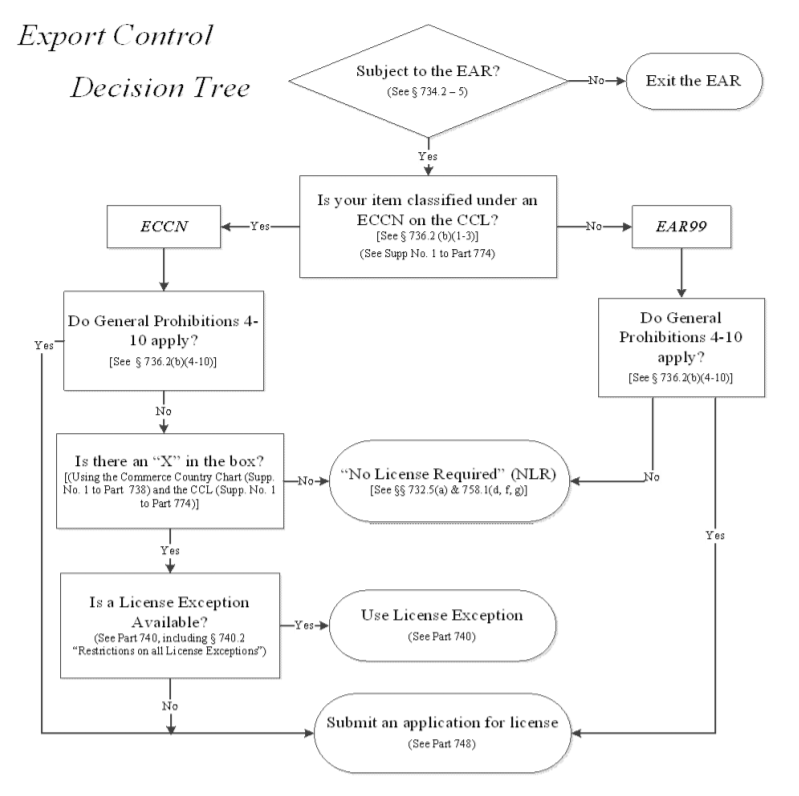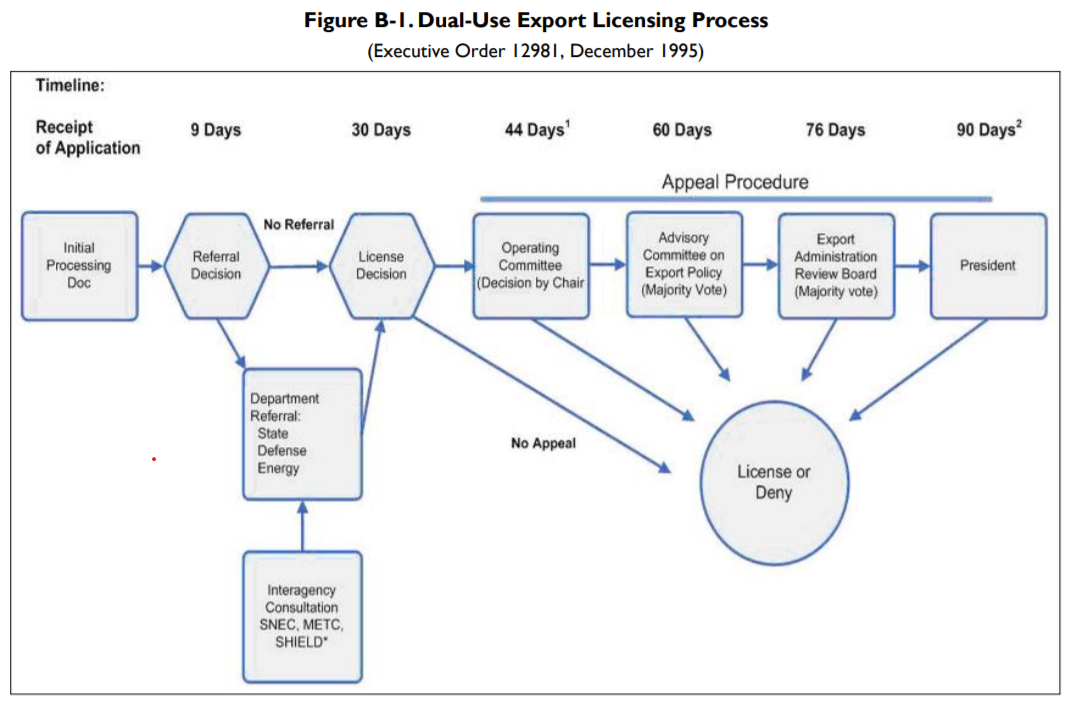Insight
December 21, 2020
Energy Technology Export Controls
Executive Summary
- Dual-use products and materials, those with both military and civilian applications, are subject to export controls.
- These export controls make U.S. clean energy technologies less competitive in the global market just as governments and consumers are prioritizing efforts to combat climate change.
- Trade barriers to the export of U.S. clean energy technologies, such as export controls, should be reformed to reduce their impact on the innovation and sale of technologies necessary to combat climate change.
Introduction
Demand for clean energy technologies has grown globally as efforts to mitigate the effects of climate change become a priority for governments and consumers alike. These technologies, however, are often dual-use technologies that rely on materials and components used for military purposes or have security implications. As a result, they are subject to export controls, which have been developed to ensure that certain technologies do not fall into the hands of malicious actors. Yet these controls also make it more difficult for U.S. manufacturers to compete around the world.
While some reforms to the export controls regime were implemented under the Obama Administration and later under the Export Control Reform Act of 2018, significant hurdles to export still exist. With the need to address climate change, policymakers should look at ways to reform trade barriers, such as export controls, so that vital clean energy technology can be distributed around the world without compromising national security. The following will examine the existing system, its impact on energy technology, and potential reforms to the export control regime.
Export Control Regulations
Several agencies are involved in implementing the Export Administration Regulations (EAR), which set out how dual-use exports are to be reviewed for safety and then, if appropriate, licensed for export. These regulations can generally be characterized as (1) product controls, which apply to particular products, services, technology, and software; (2) end-use controls, which apply to the exported products’ final use, such as military or nuclear; (3) end-user controls, which apply to the consumer who may be an individual or organization on a denied party list; and (4) destination controls, which may be in the form of embargoes or sanctions on particular countries. Exporters must consider if their transaction would trigger any of these reviews and seek out a license if necessary.[1]
Items subject to product control can be found on the Commerce Control List (CCL). The CCL contains broad categories of products subject to controls: nuclear materials, facilities, and equipment; materials, organisms, microorganisms, and toxins; materials processing; electronics; computers; telecommunications and information security; lasers and sensors; navigation and avionics; marine; and propulsion systems, space vehicles, and related equipment. These are further broken down into functional groups: equipment, assemblies, and components; test, inspection, and production equipment; materials; software; and technology.[2] These broad categories and functional groups are further broken down to more specifically identify items subject to export with an Export Control Classification Number (ECCN). Items that do not receive an ECCN but are within the jurisdiction of the Department of Commerce are designated EAR99 and may still require licensing for export if they trigger other export controls, such as end-user or destination restrictions. These controls could mean checking every transaction against a list of individuals, organizations, and governments that may be subject to sanctions, as demonstrated in the chart below.
In practice, export controls require the coordination of multiple agencies each with specific jurisdiction and expertise. While the Department of Commerce’s Bureau of Industry and Security (BIS) acts as the lead agency, it relies on others, such as the Department of Energy, where their jurisdiction extends or expertise is necessary. In addition, the agencies adhere to agreements with foreign governments regarding exports. The licensing process, shown below, was designed to be completed in 30 days, or 90 days if an appeal is lodged by one of the agencies involved in the review, except for nuclear which is not bound by a timeframe.[3]
Source: https://fas.org/sgp/crs/natsec/R41916.pdf
Impacted Technologies
Export controls undermine the competitiveness of domestic manufacturers. The complexities of compliance increase costs while the additional review time injected into the transaction by licensing creates risk and reduces confidence in manufacturers’ ability to deliver. Together, these impacts result in fewer sales and less revenue to dedicate toward continued research and development. According to surveys completed by the Department of Commerce, export controls may lead domestic manufacturers to avoid exports, abandon or alter product lines that are subject to export controls, or relocate production outside the United States. Foreign manufacturers, on the other hand, may be encouraged to find alternative providers of the controlled products or develop competing products.[4]
Both renewable energy and nuclear energy are subject to export controls in ways that hinder or complicate their sale around the world.
Renewable Energy
Under the EAR, the export of wind technology has been impacted by the product controls associated with fiberglass, the material that makes up blades, and mechanical components such as rotors. Fiberglass is regulated as both a material and as a finished product under the EAR.[5] While much of the EAR is aimed at gas turbines for use in military aircraft, the components and the machinery that may be used to build these components may be like those used for a wind turbine.[6]
Solar cells, arrays, assemblies, and panels that are “space qualified” based on their operational efficiency at particular temperatures are subject to export controls. The equipment for testing solar cells is also subject to export controls, as they are considered “discrete semiconductor devices.” Technology for the production or development of solar cells and solar panels, however, has been granted an exception.[7]
With the materials, components, final products, and equipment for building and testing to consider for any given product, the EAR proves to be a maze. It extends further to include technology in the form of documentation of the products, and it even places restrictions on foreign nationals coming into contact with this documentation as employees of the manufacturer.[8] These distinctions may prove to be restrictive for manufacturers who would rather steer clear of any product development that would blur these definitions and may even restrict their ability to hire the most qualified candidates.
Nuclear
Nuclear exports have been subject to controls in an effort to prevent the proliferation of nuclear weapons. With access to the appropriate equipment and nuclear fuels, bad actors could develop weapons. In the case of nuclear generation exports, the Nuclear Regulatory Commission (NRC) has jurisdiction of products related to facilities and materials, the Department of Energy has jurisdiction of technology, and the BIS has jurisdiction of civilian power plant equipment “outside the core.”[9] The breadth of products and materials necessary to construct a nuclear reactor is large. As a result, the NRC alone reviews export of the following equipment:
- Reactor pressure vessels,
- On-line (e.g., CANDU) reactor fuel charging and discharging machines,
- Complete reactor control rod system,
- Reactor primary coolant pumps or circulators,
- Reactor pressure tubes,
- Zirconium tubes,
- Reactor internals,
- Reactor control rod drive mechanisms,
- Heat exchangers,
- External thermal shields, and
- Any other components especially designed or prepared for use in a nuclear reactor or in any of the components described.[10]
A new generation of nuclear technology has developed in recent years, referred to as advanced nuclear, which includes microreactors and small modular reactors. Such designs are currently undergoing review for domestic licensing at the NRC.[11] These reactors generally require a smaller footprint, rely on novel fuels and cooling techniques, and serve as a smaller and more flexible generation source. A microreactor is “a small nuclear reactor that can … generate approximately 1 to 20 megawatts of electricity, and provide heat for industrial applications. Most of these small reactors are designed to be portable – many could be hauled by a semitractor-trailer. Microreactors are 100 to 1,000 times smaller than conventional nuclear reactors, while small modular reactors (SMRs) range from 20 to 300 megawatts.”[12] Because of their size, microreactors are safer and potentially less costly to operate than their predecessors. They do, however, contain novel materials and products that may not neatly fit into the existing CCL categorization scheme, creating additional barriers to their export.
Reforms
Under the Obama Administration, attempts to reform export controls resulted in restyling the list of items subject to controls, but large-scale reform, such as the consolidation of dual-use licensing under one agency, failed to come to fruition.[13] In 2018, the Export Control Reform Act restored the president’s ability to control dual-use exports, but recent reform efforts have largely been focused on countering the industrial policies of China by preventing access to innovative technologies.[14]
Policymakers should put additional focus on reforming export controls and licensing requirements for energy technologies that do not pose a threat to national security. Improvements can be made by revisiting both the mission of export controls on a high-level as well as the procedural demands of obtaining a license. Making such targeted changes can maintain the national security requirements intended in export controls while allowing valuable technology to compete abroad.
In revisiting the mission of the export control regime, consideration should be given to the extent to which technologies that were military in their origin have developed with a trajectory for civilian use and resulted in products that are a wholly new technology. For example, nuclear technology was the product of military development 80 years ago but in the following decades became commercialized in a civilian context and has since made significant progress as a source of power generation with advanced nuclear. Under the Nuclear Energy Innovation and Modernization Act, the NRC has been working to reform its review processes to better tailor it to advanced nuclear technology. The smaller design footprint and improved safety features of advanced designs require a less burdensome review of environmental implications than their light-water reactor predecessors.
Similarly, the export of advanced nuclear technologies should not be subject to the same review as its predecessors. Advanced concepts offer improved security locally and against nonproliferation as they may rely on fuels that do not pose a risk. They are advantageous to the United States and the global community in combating climate change, but they can also help to reassert the United States’ role in global nuclear leadership.
By implementing procedural changes, the burden of licensing can be reduced for manufacturers while national security is maintained. Currently, manufacturers of some products are required to obtain separate licenses for each transaction. Such licenses could be expanded to allow for multiple transactions if the buyer or country of destination remains the same. Following a review of the risks they pose, some products, particularly finished products with limited applications, could also be granted permanent exceptions to licensing if they pose little risk.
Conclusion
The reform of export controls with respect to energy products would allow for innovative technologies that can address climate change to be more readily available globally. This would prove worthwhile for not only domestic manufacturers, but also foreign governments and in the long term would support continued innovation. Any reform must ensure the security of the United States, but certain advancements mean that reform could allow manufacturers of clean energy technologies to compete abroad more easily without jeopardizing national security.
[1] https://fas.org/sgp/crs/natsec/R41916.pdf
[2] https://www.bis.doc.gov/index.php/regulations/commerce-control-list-ccl
[3] https://fas.org/sgp/crs/natsec/R41916.pdf
[4] https://www.bis.doc.gov/index.php/documents/technology-evaluation/898-space-export-control-report/file
[5]https://www.bis.doc.gov/index.php/documents/regulations-docs/2332-category-1-materials-chemicals-microorganisms-and-toxins-4/file
[6] https://www.bis.doc.gov/index.php/documents/regulations-docs/2340-ccl9-4/file
[7] https://www.bis.doc.gov/index.php/documents/regulations-docs/2334-ccl3-8/file
[8] https://fas.org/sgp/crs/natsec/R41916.pdf
[9] https://fas.org/sgp/crs/natsec/R41916.pdf
[10] https://www.nrc.gov/reading-rm/doc-collections/cfr/part110/part110-appa.html
[11] https://www.nrc.gov/reactors/new-reactors.html
[12] https://inl.gov/trending-topic/microreactors/
[13] https://fas.org/sgp/crs/natsec/R41916.pdf ; https://2016.export.gov/ecr/ ; https://2016.export.gov/ecr/eg_main_023180.asp












